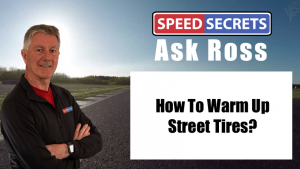 Q: “Can you comment on the differences between warming up street tires and brakes versus slicks (for track day guys using 200 treadwear tires & general knowledge)?”
Q: “Can you comment on the differences between warming up street tires and brakes versus slicks (for track day guys using 200 treadwear tires & general knowledge)?”
A: The simple answer is the process is the same: use lots of brakes on the first two laps to build heat in the brake rotors, which transfers to the hub, then to the wheel, and heats the tire from the inside. The only difference is that 200 TW tires don’t require as much heat as a race tire to begin generating good grip.
I see a lot of drivers weaving back and forth, and maybe some short bursts of acceleration and then braking. That’s not the best way to build heat in tires, no matter what type they are. First, the longer the acceleration, braking or lateral loads on the tires, the better. So, make the brake applications as long as you can, even if that means hanging back a bit from other cars, getting a long burst of acceleration, and then a longish brake application. Quick on and off applications don’t do nearly as much heat-building. The same thing applies to lateral loads. You’re best to hang back from other cars, then drive as quickly as you safely can through a corner to put as much side load into the tires for as long as you can.
Again, weaving back and forth on the track does very little beyond warming up your arms, maybe giving you a bit of a feel for the track grip, and adding a tiny bit of surface temperature to the tires. But it’s the internal air and tire carcass temperature that you really need to build up. Long acceleration and braking, and then lateral loading in corners will do a lot more than weaving back and forth.
